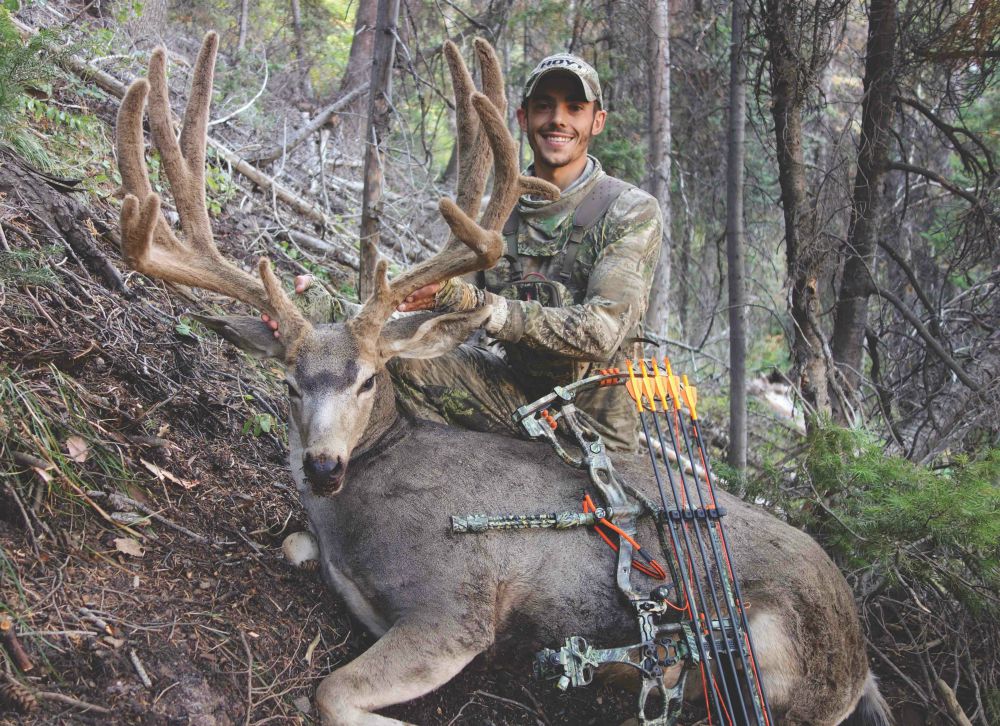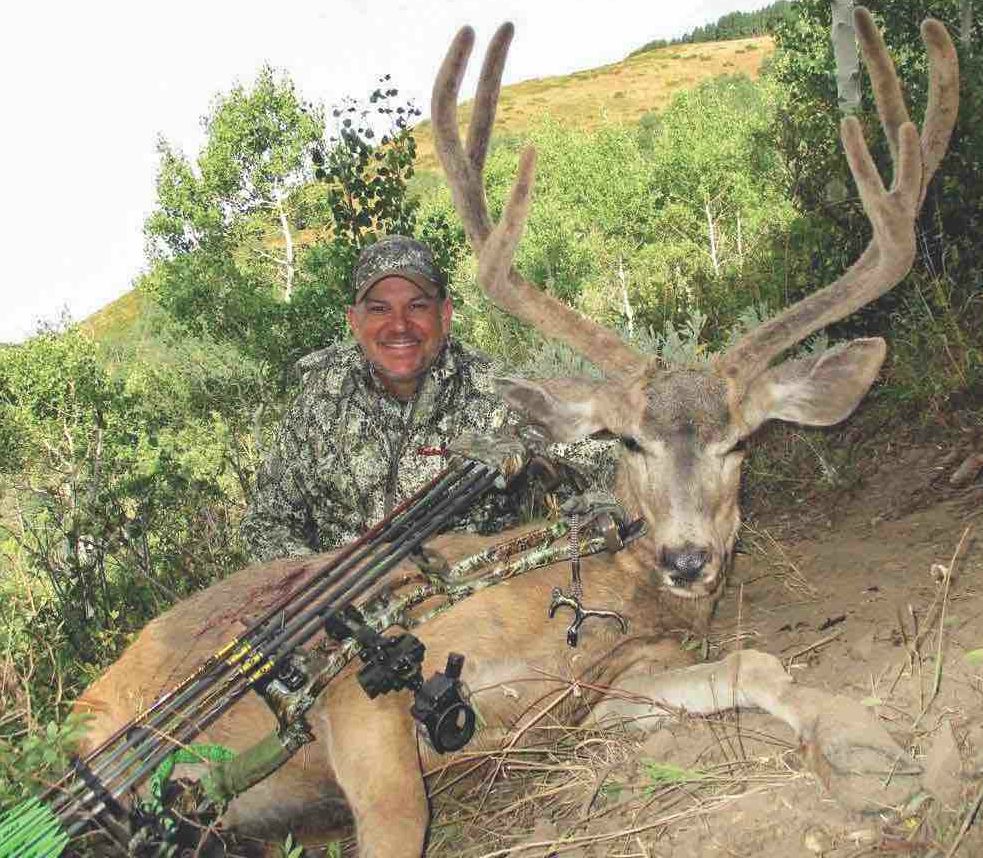Even without binoculars, I could tell he was the kind of early season mule deer I wanted. The buck’s velvet-wrapped crown carried deep forks, heavy beams, and his spread was nearly 28 inches wide. I would have considered myself lucky just to get close enough for a shot, let alone slip an arrow through his chest.
His thin summer coat stood in stark contrast against the emerald green slopes around him, and his tank-sized body dwarfed the other bucks he was palling around with. Best of all, the bedding area he seemed to be feeding toward offered an excellent opportunity for a midday stalk. For nearly 2 hours I watched as he fed on the lush green shoots, and with each passing minute, he grew more impressive.
I had initially located him the previous afternoon, and I desperately wanted to sneak into range at that time, but Mother Nature forced other plans. Just as I was about to ditch my pack and close the distance, dark clouds and fickle winds rushed in unannounced. Over the years I have learned there are many things that are in a hunter’s control, but capricious mountain winds aren’t one of them.
During the early season, mule deer tend to keep the same daily routine if left undisturbed. And just like he did the previous day, the buck eventually bedded in the same brushy thicket with his companions. I watched them for the next couple of hours, studying every detail of a potential stalk, waiting for the mountain thermals to stabilize in a more hunter-friendly direction.
With a plan in place, I slipped in without a hitch. When his thick, fuzzy antlers rose above the brush and began moving in my direction nearly an hour later, time slowed to a snail’s pace and I watched him ease toward a boulder-sized hole in the brush. When his chest appeared, I settled my pin and gently touched the trigger. Arrows always seem to fly faster in the thin mountain air, and when it buried fletch deep, I knew the hunt was over.
Early Season Mule Deer: A Systematic Approach
For some there’s perhaps no greater Western bowhunting experience than matching wits with a mature early season muley buck. More times than not, it ends up being a chess match of sorts in which finding, patterning, stalking and ultimately killing the buck you’re after is the pinnacle of the season. To be honest, it’s rarely easy, and it often takes a systematic approach to finally knock over the king of the mountain.
Obviously, scouting is key, and for some, like noted Utah bowhunter Sean Morgan, it’s really the foundation of his success. “It’s no secret,” said Morgan, “time and effort is really what puts you in the game on an early season buck.”
How accurate is this advice? Just one look at his buck-killing resume will tell you he has something figured out. In 2013, Morgan killed his first 200-inch Utah giant, and that was followed up again in 2015 with a 206-inch toad he had affectionately nicknamed Maverick. With several other bucks in the 175- to 189-inch class to his credit as well, there’s a method to Morgan’s muley madness.

Sean Morgan is a muley master, and this fine public land buck is a shining example of his muley wizardry.
For Morgan, this effort begins in mid-June and stretches to season opener. During this timeframe, he’ll make several early morning scouting trips each week in an effort to locate and pattern specific bucks. Because Morgan hunts Utah’s famed Wasatch Front, which receives intense hunting pressure, he scouts multiple areas throughout the summer in an effort to find several locations that hold deer. In fact, every buck Morgan has killed in this region has come from a different area. Keep that in mind wherever your muley dreams take you.
While many bowhunters get frustrated by hunting pressure, Morgan tends to embrace it by hunting around the pressure and using it to his advantage. In fact, the first 200-inch buck he killed was ambushed as the buck was slipping across the canyon in an attempt to elude approaching hunters. Knowing how hunters generally approached this particular canyon, Morgan was waiting on the other side and capitalized on the buck’s mistake.
Although glassing from a distance is a key element to Morgan’s success during the summer months, he also utilizes trail cameras in specific areas to enhance his efforts. Ideally, he likes to set them up on each side of an isolated pocket of timber. Doing so helps him locate deer he may have overlooked, or relocate a buck that disappeared during the scouting season.
The Traveling Hunter
What about the bowhunter that lives hundreds or thousands of miles from their favorite muley haunts? I’d advise you to take Marc Smith’s advice. Being 800 miles from his favorite mule deer stomping grounds has not hampered his efforts. With well over 15 Pope & Young bucks to his credit, Marc Smith seems to find a way to wrap his tag around a buck or two nearly every season.
While boots-on-the-ground scouting is important, says Smith, cyber-scouting online, networking with other hunters, map reading, as well as using sources like the P&Y and B&C record books to find trophy trends is where he starts when it comes to finding new areas. Although Smith says this may be a little “old school,” it’s still an effective way to locate specific areas that hold potential mule deer gold mines.
Ideally, Smith likes to hunt remote areas, but not so remote that it hampers his ability to move to a completely different area if needed.
“When you’re 10 miles back in, you’re pretty much married to that spot,” Smith said, “and when you have only a week to hunt, it’s good to have the ability to be mobile.” Locales that are generally 2 to 3 miles away from his truck are remote enough to put him out of reach of most other hunters and allow for the flexibility to move if need be.
Smith also likes to locate areas that allow him to gain as much elevation as possible from the trailhead in a relatively short amount of time, and have an ample supply of north- and northeast-facing slopes with pockets of cover and water. These types of areas are where early season mule deer bucks tend to hang out, and they also provide excellent opportunities for glassing and stalking.
Stalking Early Season Mule Deer
Once you’ve located the bucks you want to hunt, it’s time to get into bow range. It doesn’t matter if you’re stalking a bedded buck or trying to ambush one as he’s feeding in your direction, patience is perhaps the most critical element when it comes to finding success. There are many factors to putting velvet-covered antlers on the ground, but patience — waiting on the perfect opportunity — is the constant element woven into virtually every one of them.
When it’s time to make a move, you should do so only in perfect situations. Consistent wind direction, the buck’s position, available cover, potential shot opportunities and, perhaps the most overlooked, other deer bedded in the area, are all elements that should be considered. When everything is right and it’s time to start moving in, be meticulous in your approach. If you think you’re moving slow, move even slower. These bucks are experts at surviving, and they are extremely sensitive to their surroundings.
Lastly, time and dedication are critical to a successful early season mule deer bowhunt. Mature bucks don’t live in every drainage, and it takes an enormous amount of time, dedication and energy to locate the buck you want. Success with these hunts rarely comes quickly. In fact, I can remember only one time when I found success on the first day. Most of the time I end up spending more time watching and waiting for an opportunity than actually hunting. Don’t let this discourage you. It’s part of the process.
What’s New in Bowhunting World
DO YOU NEED AN ATTITUDE ADJUSTMENT? I DID.
PATTERNS FOR PUBLIC LAND WHITETAIL SUCCESS
VIDEO: DON’T LOSE A FINGER THIS FALL — GET A GROOVE RING








